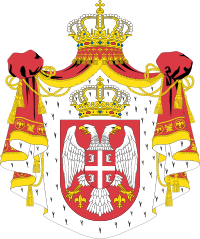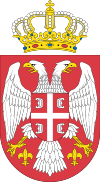Coat of arms of Serbia
| Great Coat of arms of Serbia | |
 |
|
| Versions | |
|---|---|

Small Coat of Arms of Serbia
|
|
| Details | |
| Adopted | 1882/2004 |
The Coat of Arms of Serbia is the same as the coat of arms of the former Obrenović dynasty (first adopted in 1882; re-adopted in 2004) and features the white bicephalic eagle of the House of Nemanjić (which in turn took on the eagle from the Palaiologos dynasty of the Byzantine Empire). An ermine cape of the style once worn by kings is featured in the background. The double-headed eagle has been used since Byzantine times, the Serbian cross has been used since the 12th century.
Design
The principal field stands for the Serbian State. It consists of a double-headed eagle on a red shield; its body and wings in silver, and tongues, beaks, legs and claws in gold, between two golden fleurs-de-lys. The inescutcheon stands for the Serbian Nation; in a red shield, a cross between four silver firesteels arranged in the quarters around it, all of them facing horizontally outwards.
A blazon in heraldic terms is: Gules, a bicephalic eagle Argent armed Or, two fleurs-de-lys Or. Overall an escutcheon Gules, a cross Argent between four firesteels Argent. All crowned with a royal crown. The design on the inescutcheon has been used by Serbian states and the Serbian church since the Middle Ages.
Although Serbia is now a republic, the new coat of arms also features the crown of the former Serbian monarchy. A crown in this manner usually signifies a monarchical form of government. However in recent years several Eastern European nations have used a crown to signify their royal heritage. Russia and Poland have similarly both restored coat of arms bearing crowns despite being republics.
See also
- Flag of Serbia
- Coat of arms of the Socialist Republic of Serbia
- Emblem of Republika Srpska
External links
- Serbian Heraldic Society; its president and board members are also members of the Privy council of HRH Karadjordjevic and advisors for the Serbian state on State heraldry
- Serbian Coat of Arms
- The Society of Heraldic Enthusiasts Milosh Obilich
|
|||||||||||